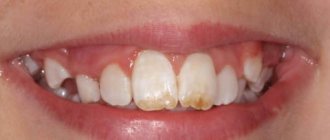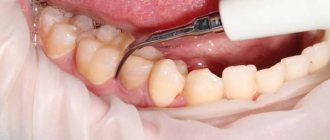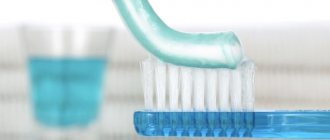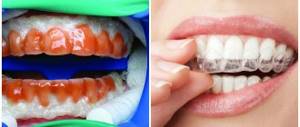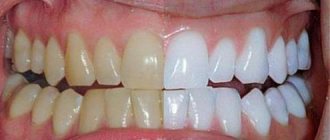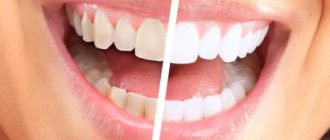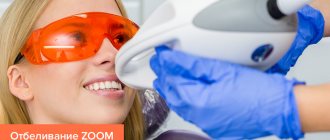Author of the article:
Soldatova Lyudmila Nikolaevna
Candidate of Medical Sciences, Professor of the Department of Clinical Dentistry of the St. Petersburg Medical and Social Institute, Chief Physician of the Alfa-Dent Dental Clinic, St. Petersburg
Dentists are ambivalent about the procedure, highlighting a large number of disadvantages of whitening. The fact is that healthy teeth in any case have a tint; most often it is yellow, but it can also be grayish. Dentin is responsible for the color, which shines through the translucent protective layer of enamel.
A bright white Hollywood smile is far from a sign of healthy teeth. The fact is that enamel lightening is a purely cosmetic procedure, which, even when using the most modern methods, remains quite harmful, as it weakens the health of the teeth, leads to increased sensitivity and loss of minerals.
To make the procedures safer, it is necessary to use special toothpastes that will help relieve pain and protect fragile tooth enamel, for example, ASEPTA Sensitive, it remineralizes weakened enamel and reduces its sensitivity after whitening. The calendula and calamus extracts it contains help prevent the proliferation of pathogenic bacteria, and the sweet clover extract reduces gum inflammation.
Content:
- AirFlow is not whitening
- What is real bleaching like?
- Pastes with a whitening effect are the easiest option for improving the appearance of enamel
- Professional techniques - a chance to get the smile of your dreams
- How doctors whiten teeth
- Possible harms of teeth whitening
- When bleaching is harmful and contraindicated
No matter how positively dentists speak about the natural color of enamel, many people want to become the owners of a snow-white smile.
They are not embarrassed by the harm of teeth whitening, since the issue of aesthetics comes to the fore for them. Can whitening activities really harm your health? In fact, most often complications can be avoided. But to do this, you need to make an appointment with an experienced specialist and conduct therapy using the most modern techniques.
Contraindications
In some cases, teeth whitening is not just harmful, but unacceptable. Your doctor will determine whether you can whiten your teeth or not. If a patient has contraindications, but still whitens his teeth, he may face serious oral diseases.
Diseases and conditions for which teeth whitening is contraindicated:
- open caries;
- pathological abrasion of enamel;
- deep cracks in teeth;
- gum disease;
- wearing braces;
- exposure of tooth roots;
- allergy to bleaching agents.
In addition, teeth whitening is contraindicated for minors, as well as pregnant and breastfeeding women.
AirFlow is not whitening
AirFlow is a technique that involves abrasively cleaning units. Some people think that it is aimed at lightening the enamel. In fact, this is not true. This is a standard hygiene procedure used to remove soft plaque and hardened tartar.
Since crowns are thoroughly cleaned during an AirFlow session, their appearance becomes much more aesthetically pleasing. However, there is no harm to oral health. Dentists recommend undergoing professional hygiene every year. This will keep your teeth and gums in good condition and reduce the likelihood of cavities forming.
Recommendations after whitening
Features of caring for teeth and maintaining their “shape” depend on the type of whitening. Moreover, before the procedure it is necessary to carry out a number of preparatory manipulations.
- Examination of the oral cavity, X-ray examination and identification of possible contraindications. These include cancer, diabetes, allergies to ultraviolet radiation, and active dental diseases. Whitening is also contraindicated for pregnant women and people under 18 years of age.
- Professional oral cleaning.
- In-office whitening usually requires one procedure. After this, remineralizing therapy is carried out, which will restore the enamel after the procedure. To consolidate the results, a course of home whitening is prescribed, which can last up to a month. If the patient wants to undergo only a course of home whitening, he also needs to consult with a doctor, who will also help him choose the optimal system.
What is real bleaching like?
Negative consequences of teeth whitening are possible if a whitening compound is applied to the crowns. It affects the structure of the enamel, destroys and washes out the yellow pigment. Before professional bleaching, it is necessary to carry out hygiene. Otherwise, the white color will “lay down” unevenly, which will look strange and unaesthetic.
To plan the final result of aesthetic therapy, dentists use a special scale. It is used to determine what tone the patient’s teeth have at the time of treatment (most often this is A3) and what he wants to have as a result of all medical procedures. Most people want to get shade A1 - it is the lightest on the scale.
Is it good? Striving for an unnatural white smile is not healthy. If your teeth are naturally yellow, you should not repeat the aesthetic treatment several times. It’s better to stop after lightening the enamel by several tones. Trying to get the smile of Hollywood stars can harm your own health.
Is laser whitening harmful?
This is the safest way to white teeth. The laser beam (acting as a catalyst) does not heat the dental tissues and does not harm them. The procedure lasts about 40 minutes and is painless, although slight discomfort is possible.
In addition, under the influence of the laser, the enamel is densified by approximately 30%, and this is an additional factor of protection against food acids and bacteria. The only disadvantage of laser whitening is its high cost (from 20,000 rubles).
Laser whitening
Pastes with a whitening effect are the easiest option for improving the appearance of enamel
On sale you can find a huge number of special pastes, which contain abrasive and chemically active components. With regular use, they make teeth lighter and help get rid of unsightly yellow-gray plaque that appears due to:
- eating foods high in dyes;
- habits of drinking a lot of strong black tea and coffee;
- smoking;
- poor oral care.
But pastes cannot remove pigments located in the deep layers of enamel. They act superficially. Therefore, the result they provide will suit only people who do not strive for a Hollywood smile.
It is important to consider that bleaching hygiene products are highly abrasive. This means that they are ways to increase tooth sensitivity. For this reason, it is permissible to use them for short courses. It is prohibited to use them on an ongoing basis.
Professional techniques - a chance to get the smile of your dreams
Conventionally, all methods used in dental clinics can be divided into two large groups:
- providing for activation of the solution by light;
- not requiring activation of the gel with light.
The gel itself, applied to the crowns, has approximately the same composition. Its active compounds are hydrogen peroxide and urea. Dental products differ from each other only in the concentration of these compounds.
The ZOOM method is considered the most effective today. It requires activation of the gel with a lamp. If its first versions caused discomfort in patients and required the use of local anesthetics, then with the advent of ZOOM-4 the need for pain relief disappeared.
How doctors whiten teeth
Conventionally, the entire process can be divided into successive stages:
- The doctor carefully examines the oral cavity and determines whether there are any dental diseases. If they are diagnosed, they are pretreated. Professional hygiene is mandatory. It cleanses the enamel and makes it more receptive to the lightening agent.
- Upon completion of preparation, the doctor isolates the mucous membranes of the mouth so that aggressive drugs do not come into contact with them. Then coats the teeth with gel. If necessary, he directs a lamp at them (in this case, the patient wears special safety glasses). You have to wait about fifteen or twenty minutes. Then the product is removed and the primary result is assessed. Afterwards the procedure is repeated again. In just one visit to the dental clinic, there may be two or three such repetitions - more is undesirable, since then the harm of teeth whitening will increase.
- Immediately after therapy, the dentition is treated with a strengthening remineralizing composition. It is needed to avoid increased tooth sensitivity.
It is important to agree with your doctor on the conventions. By holding the mouthguard in the mouth, the patient will not be able to tell if he is experiencing pain or other discomfort. Therefore, signs should be invented . For example, a wave of the left hand may indicate pain symptoms, while a nod of the head may indicate that everything is in order.
The patient should be aware that a slight tingling sensation in the area of the treated units is normal. But severe pain should not appear. If it occurs, under no circumstances should you wait until the end of the session. Sacrificing dental health for aesthetics is, to say the least, unwise. After all, you will then have to undergo a long recovery.
Possible harms of teeth whitening
The content of lightening components in whitening pastes is very low - usually up to 5%. In products designed for use in the dentist's office, it is approximately five times higher. This leads many to think that it is safer to regularly brush your teeth at home with a good toothpaste with a whitening effect. But it is not so. Long-term exposure to low concentrations appears to be more harmful than single exposure to high concentrations.
Of course, after professional whitening, the risk of increased sensitivity, the spread of caries, and gum inflammation increases. But these complications can be avoided. To do this you need:
- use only high-quality and safe drugs during the procedure;
- do not repeat therapy more often than once every six months;
- strictly follow all medical prescriptions during the post-treatment period;
- preliminary remineralization of the enamel.
Harm and benefit
Professional systems for teeth whitening at home based on peroxide gel (for example, White Light, Opalescence) are advertised by manufacturers as absolutely harmless. Indeed, the use of such products does not harm the teeth and restores their natural whiteness. But only if the technology for their use is correct.
The most common mistakes that cause home whitening systems to damage tooth enamel are:
- Application of the technique without prior consultation with a dentist.
- Using a drug that is not suitable for the type of teeth.
- Exceeding the required exposure time of the gel.
- Independently increase the number of whitening procedures.
- Teeth whitening is done more often than once every 1-2 years.
Failure to follow the whitening rules may result in burns to the gums and mucous membranes of the lips and cheeks, and increased tooth sensitivity to temperature changes and acid.
Are compact whitening products safe?
Teeth whitening products in the form of gels, pencils, and plates are becoming increasingly popular. Their action is also associated with active hydrogen peroxide. When used correctly, they are absolutely harmless.
But excessive enthusiasm for such enamel lightening, an incorrectly selected or low-quality preparation can provoke the same negative effects as any other peroxide-based product: destruction of dental tissue, increased sensitivity, caries.
How harmful is in-office whitening?
Coming to the dentist's office, many patients wonder whether professional whitening (laser, Zoom) is harmful?
Today, techniques used in the dentist’s office that significantly whiten tooth enamel are the safest.
- All drugs used for the procedure have undergone repeated testing and have proven to be harmless to tooth enamel.
- The technologies are verified down to the minute, so the possibility of “over-whitening” and obtaining an unnatural chalky shade of teeth is practically eliminated.
- The gels contain components that, while lightening the enamel, remineralize it and protect it from destruction.
- The process takes place under the constant supervision of a doctor. Therefore, if any complications or discomfort occur, bleaching can be stopped.
- After the procedure, the surface of the teeth is treated with special solutions that reduce sensitivity and protect the enamel from caries.
Many studies of laser whitening provide evidence that such systems are safe, but also beneficial. Under the influence of laser radiation, the enamel tissue is densified by about a third, which serves as an additional protection factor.
Zoom whitening, popular today, is one of the safest methods.
In what cases can professional whitening be harmful?
In order to be confident in the safety of all manipulations performed, you should choose a proven clinic with a good reputation and a large number of positive patient reviews.
Otherwise, you may get a completely unexpected result.:
- The use of low-quality gels may not only fail to improve the color of tooth enamel, but also cause a sharp increase in its sensitivity. Getting rid of such a complication can be quite difficult.
- Lamps used for photobleaching have a certain service life, after which the light spectrum can change and become hazardous to health. Working with such lamps can lead to serious burns to mucous membranes and skin.
- Increasing the exposure period of the active peroxide gel in order to obtain a greater effect leads to the fact that the tooth enamel becomes a chalky matte shade.
- Incorrect or inadequate treatment of the tooth surface with remineralizing solutions increases the risk of destruction of dental tissues.
When choosing what to whiten your teeth with, you should rely on the opinion of professionals. Only a dentist can adequately assess the condition of the enamel and answer the question of whether using a particular technique is harmful or not. Attempts to make your smile whiter on your own may not only fail, but also cause serious complications that will be quite difficult to eliminate.
